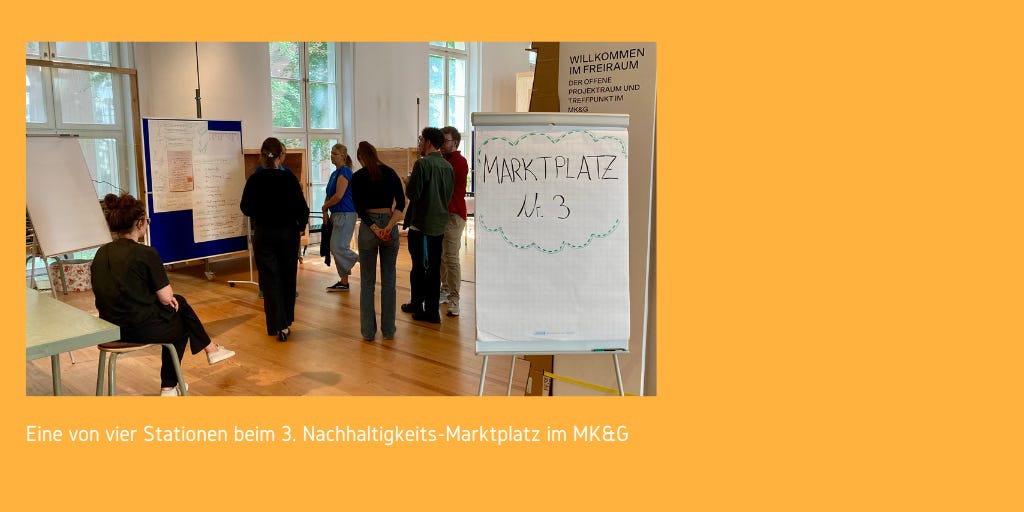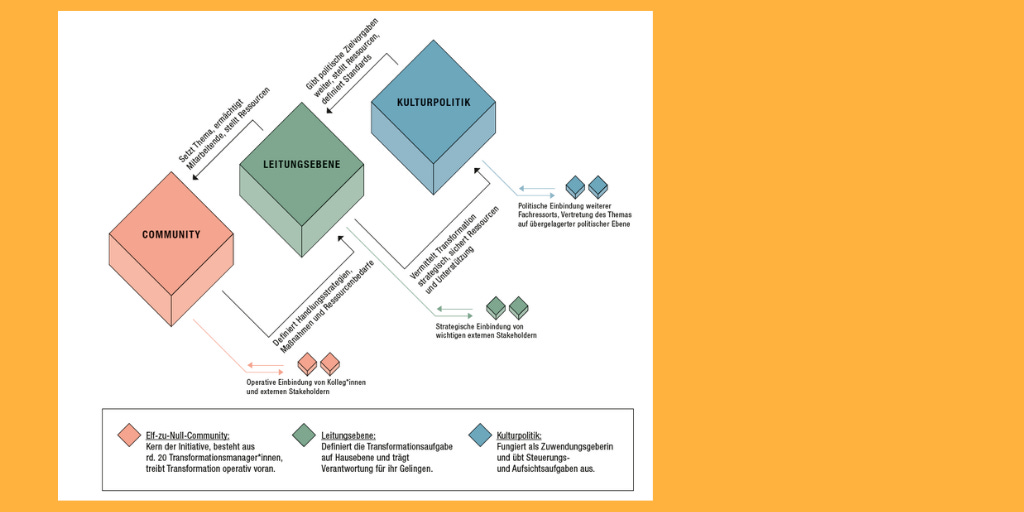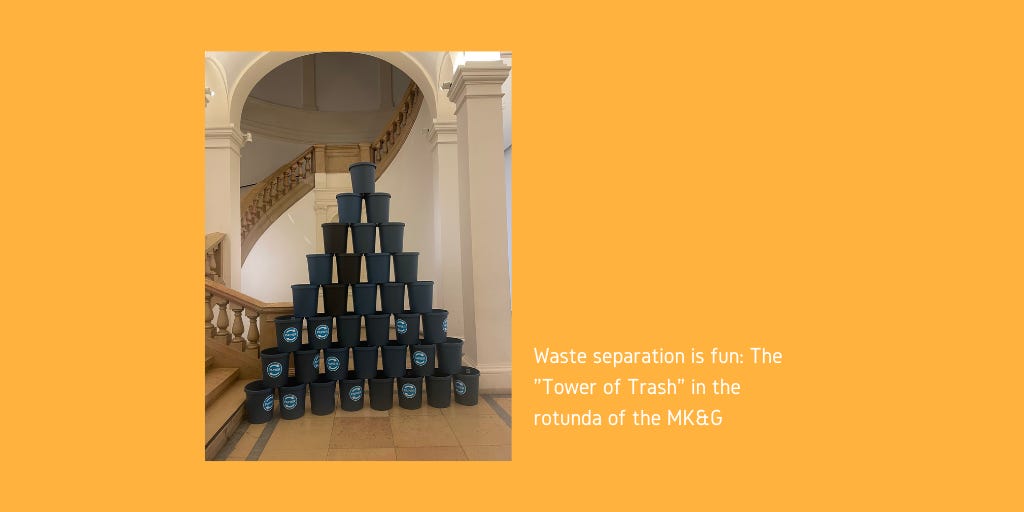Please find the English Version below
Willkommen zur neuen Ausgabe von Spotlighting Museums, in der Alexander Stockinger, Vorstand und kaufmännischer Geschäftsführer des Museums für Kunst und Gewerbe Hamburg, seine Erfahrungen in dem von ihm initiierten Projekt „Elf zu Null” mit uns teilt.
Vom Dino zum Dynamo. Wie elf Hamburger Museen das Thema Nachhaltigkeit mit Schwung voranbringen
Seit August 2022 gibt es die Nachhaltigkeitsinitiative „Elf zu Null – Hamburger Museen handeln“. Fast ein Dutzend Museen, Ausstellungshäuser und Gedenkstätten haben sich darin zusammengeschlossen, um die ökologische Transformation der Institutionen auf den Weg zu bringen. Ziel ist, bis 2045 Netto-Null-Emissionen zu erreichen. Dafür wurden rund 20 Mitarbeitende zu Transformationsmanager:innen fortgebildet, Klimabilanzen erstellt, Nachhaltigkeitskonzepte erarbeitet und diverse Maßnahmen auf den Weg gebracht. Im Folgenden teilen wir Erfahrungen aus bald zwei Jahren „Elf zu Null” und garnieren diese jeweils mit einem Literaturtipp, der uns inspiriert hat, anders zu arbeiten als bisher.
Netzwerke statt Silos – Menschen und Informationen verbinden
Eigentlich war die Vernetzung nur als Nebeneffekt der Transformationsarbeit gedacht – mittlerweile sind wir aber überzeugt, dass dies einer der wichtigsten Erfolgsfaktoren von „Elf zu Null” ist. Je komplexer die Herausforderung, desto komplexer auch die Lösungswege, desto mehr Menschen und Arbeitsbereiche sind zu involvieren, desto besser muss Wissen vernetzt werden. Und kaum etwas ist derzeit komplexer als die Klimakrise. Insofern gilt: Ego zurückstellen, Wissensmonopole aufbrechen! Im Team von „Elf zu Null” wird Wissen vertrauensvoll und großzügig geteilt, wird sich bei Widerständen kollegial beraten, wird nach außen hin geschlossen gegenüber wichtigen Stakeholdern aufgetreten. All das wird mittlerweile orchestriert von einer Netzwerkmanagerin, die – wie passend – ihre Masterarbeit zum Thema Kollaboration in Museen geschrieben hat.
Literaturtipp
„The Silo Effect. Why Every Organisation Needs to Disrupt Itself to Survive“. Die Anthropologin und Journalistin Gillian Tett illustriert eindrucksvoll, wie der Umgang mit Silos (geschlossenen Informationszirkeln) über Erfolg oder Misserfolg von Organisationen entscheidet.
Grafik: Vergrößerung des Bildes hier
Führung in alle Richtungen
Eines ist klar: Ohne klare und starke Unterstützung des Top-Managements geht es nicht! Gleichzeitig liegen die fachliche Expertise und Prozesskompetenz im Fall von „Elf zu Null” bei den 20 Transformationsmanager:innen. Sie müssen deshalb ermächtigt werden, Führungshandeln mitzugestalten. Wir denken die ökologische Transformation als einen Vorgang der „Führung in alle Richtungen“, siehe auch hier. Jede beteiligte Stakeholdergruppe hat dabei Top-Down-, Bottom-Up- sowie laterale Führungsaufgaben.
Literaturtipp
„Reinventing Organisations. Ein Leitfaden zur Gestaltung sinnstiftender Formen der Zusammenarbeit“ von Frederic Laloux spannt den organisationsentwicklerischen Bogen von steinzeitlichen Klans bis hin zu holokratischen Organisationen der Jetztzeit. Ein Klassiker.
Iteration statt Perfektion
Mitte 2023 waren wir paralysiert: Wir hatten unsere Fortbildung, unsere Klimabilanzen und Nachhaltigkeitskonzepte in der Tasche. Doch wie weiter? Ein Gedanke, der uns aus der Paralyse befreit hat, stammt von dem Berater Eric Poettschacher: Fokussieren Sie auf die nächste mögliche Aufgabe – the next possible thing.
Dieser Maxime folgend haben wir unsere Arbeitspakete ausgewählt und arbeiten nun in zwei Gruppen an immer zwei konkreten Projekten. Die Projekte werden in Zyklen bearbeitet, an deren Ende ein greifbares Ergebnis steht: eine Dienstreisepolicy, ein Klimakorridor, ein Abfallmanagementsystem, etc. Am Ende des Zyklus werden die nächsten Schritte definiert, neue Aufgaben ausgewählt, Teams neu zusammengestellt – und weiter geht’s!
Literaturtipp
In „The Fearless Organisation. Creating Psychological Safety in the Workplace for Learning, Innovation, and Growth” skizziert die Harvard-Professorin Amy Edmondson eine mutige und umfassend ermächtigte Arbeitswelt.
Ran an die Struktur
Früher oder später muss Nachhaltigkeit vom Change-Projekt zum regelhaften Prozess werden. Um das zu schaffen, müssen den Bekenntnissen konkrete Taten folgen. Nachhaltigkeit muss strukturell in Institutionen verankert werden: in Abläufen, in den Kompetenzen des Teams und in der Hierarchie. Das kann sich zeigen in routinehaften Formaten, angepassten Stellenbeschreibungen, neu gewichteten Vergabekriterien, etc. Nur so stellt man sicher, dass Nachhaltigkeitshandeln keine Einzelfallentscheidung wird. Für uns ist die strukturelle Verankerung aktuell der schwierigste Aspekt der Transformation, aber auch hier gilt: the next possible thing!
Literaturtipp
„Die Humanisierung der Organisation. Wie man dem Menschen gerecht wird, indem man einen Großteil seines Wesens ignoriert“ bietet ein flammendes und durchaus provokantes Plädoyer für die Strukturarbeit in Organisationen.
Footprint meets Handprint
Kulturinstitutionen haben über die bloße hausinterne Veränderung ihrer betrieblichen Abläufe eine riesige Chance. Sie können nicht nur ihren Ressourcenverbrauch reduzieren (Footprint), sondern ihre gesellschaftliche Wirkung maximieren (Handprint). An die 2 Mio. Gäste besuchten die Elf-zu-Null-Häuser 2023! Was für ein Potenzial, die Debatte über Nachhaltigkeit zu bestärken, zum Handeln motivieren und als Multiplikator wirken. Um die gesellschaftlichen Wirkmechanismen von Museen besser zu verstehen, wird derzeit anhand der Ausstellung „Water Pressure. Gestaltung für die Zukunft“ im MK&G eine Forschungsarbeit verfasst.
Literaturtipp
Wie gesellschaftliche Wirkung entsteht und analysierbar ist, zeigt das „Kursbuch Wirkung“ von PHINEO. Vom Output über Outcome zum Impact, immer die Wirkungstreppe hoch!
PS, PPS und PPPS
1) Wir suchen weiterhin Förderer, die „Elf zu Null” finanziell und ideell unterstützen.
2) Die Ergebnisse unserer zweiten Klimabilanzierung werden Ende Mai veröffentlicht (www.elfzunull.de)
3) Wir teilen unsere Erfahrungen gerne mit interessierten Kolleg:innen.
Ansprechpartnerin für alles: Caroline Markiewicz, caroline.markiewicz@mkg-hamburg.de
Ein herzliches Dankeschön an Alexander Stockinger vom Museum für Kunst und Gewerbe Hamburg für die inspirierenden Ausführungen zur Dynamik von elf Museen, die Nachhaltigkeit ins Zentrum ihrer Zusammenarbeit stellen. In eigener Sache möchte ich nicht versäumen, darauf zu verweisen, dass das Museum für Kunst und Gewerbe Hamburg auch zu den Museen gehört, die wichtige Weichen für unser Programm Das relevante Museum gestellt haben und sicher auch weiter noch stellen werden. Wir freuen uns darauf!
Vielen Dank für Ihr Interesse an unserem Newsletter. Ich wünsche Ihnen allen freundliche Sonnentage!
Herzliche Grüße
Katja Stark, NORDMETALL-Stiftung
English Version
Welcome to the new issue of Spotlighting Museums, in which Alexander Stockinger, board member and financial director of the Museum für Kunst und Gewerbe Hamburg, shares with us his experiences with the project he initiated “Elf zu Null”(Eleven to Zero).
From dino to dynamo. How eleven Hamburg museums are driving sustainability forward
Since August 2022, there has been the sustainability initiative “Elf zu Null – Hamburg Museums Act”. Almost a dozen museums, exhibition halls and memorial sites have joined forces to initiate the ecological transformation of their institutions. The goal is to achieve net-zero emissions by 2045.
To this end, around 20 employees have been trained as transformation managers, carbon footprints have been drawn up, sustainability concepts have been developed and various measures have been initiated. In the following, we share experiences from almost two years of „Elf zu Null” and garnish them each with one reading recommendation that has inspired us to work differently than before.
Networks instead of silos – connecting people and information
Actually, networking was only intended as a side effect of the transformation work – but now we are convinced that this is one of the most important success factors from “Elf zu Null”. The more complex the challenge, the more complex the solutions, the more people and areas of work have to be involved, the better knowledge needs to be interlinked. And hardly anything is currently more complex than the climate crisis. In this respect, the following applies: put your ego aside, break up knowledge monopolies! In the team of “Elf zu Null”, knowledge is shared in a trusting and generous manner, there is collegial advice in the event of obsticals, and we speak with one voice to important stakeholders. All of this is now orchestrated by a network manager who – matching perfectly – wrote her master's thesis on the topic of collaboration in museums.
Recommended reading
“The Silo Effect. Why Every Organisation Needs to Disrupt Itself to Survive”. The anthropologist and journalist Gillian Tett impressively illustrates how dealing with silos (closed information circles) determines the success or failure of organisations.
Graphic: Enlarge document here
Leadership into every direction
One thing is clear: it won't work without clear and strong support from top management! At the same time, the technical expertise and process competence in the case of “Elf zu Null” lie with the 20 transformation managers. They must therefore be empowered to help shape leadership actions. We think of ecological transformation as a process that needs “leadership into all directions”. Each stakeholder group involved has top-down, bottom-up and lateral leadership tasks.
Recommended reading
“Reinventing Organisations. A Guide to Creating Organizations Inspired by the Next Stage in Human Consciousness” by Frederic Laloux spans the organisational development arc from Stone Age clans to holocratic organisations of the present day. A classic.
By mid-2023, we were paralysed: we had our training, our carbon footprints and sustainability concepts in our pockets. But what next? One thought that has freed us from paralysis comes from the consultant Eric Poettschacher: Focus on the next possible thing. Following this maxim, we have selected our work packages and are now working in two groups on two concrete projects at a time. The projects are worked on in cycles at the end of which there is a tangible result: a business travel policy, a climate corridor, a waste management system, etc. At the end of the cycle, the next steps are defined, new tasks are selected, teams are reassembled – and off we go!
Recommended reading
In “The Fearless Organisation. Creating Psychological Safety in the Workplace for Learning, Innovation, and Growth”, Harvard professor Amy Edmondson outlines a courageous and comprehensively empowered work environment.
Get to the structure
Sooner or later, sustainability must develop from a change project into a regular process. In order to achieve this, the commitments must be followed by concrete actions. Sustainability must be structurally anchored in institutions: in processes, in the competencies of the team and in the hierarchy. This can be reflected in routine formats, adapted job descriptions, reweighted award criteria, etc. This is the only way to ensure that sustainability action does not become a case-by-case decision. For us, structural anchoring is currently the most difficult aspect of the transformation, but here, too, applies: always go for the next possible thing!
Recommended Reading
“The humanisation of the organisation. How to do justice to people by ignoring a large part of their being” offers a flaming and thoroughly provocative plea for structural work in organisations.
Footprint meets Handprint
Cultural institutions have a huge opportunitythat goes beyond simply changing their operational processes in-house. They can not only reduce their resource consumption (footprint), but also maximize their social impact (handprint). Around two million guests visited the Elf zu Null museums in 2023! What a potential to strengthen the debate on sustainability, motivate action and act as a multiplier. In order to better understand the social impact mechanisms of museums, a research paper is currently being written on the basis of the exhibition “Water Pressure. Design for the Future” in the MK&G.
Recommended Reading
How social impact arises and can be analysed is shown in PHINEO's “Kursbuch Wirkung”. From output to outcome to impact, always up the impact ladder!
PS, PPS and PPPS
1) We are still looking for funders who support “Elf zu Null” financially and ideally.
2) The results of our second carbon footprint will be published at the end of May (www.elfzunull.de)
3) We are happy to share our experiences with interested colleagues.
Contact person: Caroline Markiewicz, caroline.markiewicz@mkg-hamburg.de
A big thank you to Alexander Stockinger from the Museum für Kunst und Gewerbe Hamburg for his inspiring remarks on the dynamics of eleven museums that place sustainability at the center of their collaboration. On my own behalf, I would like to point out that the Museum für Kunst und Gewerbe Hamburg is also one of the museums that have set and will certainly continue to set an important course for our programme Relevant Museum. We are looking forward to it!
Thank you for your interest in our monthly newsletter. I wish you all friendly sunny days!
Best wishes
Katja Stark, NORDMETALL-Foundation
















